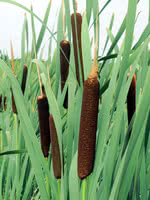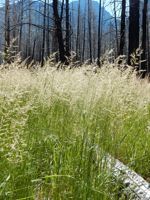Mon-Fri 9am - 5pm Mountain time
Common Cattail vs Bluejoint
Typha latifolia
Calamagrostis canadensis
CUSTOM GROW
CUSTOM GROW
Cattail is found all across North America, growing next to water. Like other waterside plants, Cattail provides erosion control and forage for animals.
It is suitable for land reclamation. Cattail is able to tolerate cold weather and occasional flooding.
Bluejoint is a native perennial grass that forms tall, dense colonies. It is one of the most abundant grasses found in Canada and the United States. The extensive shallow root system and spreading rhizomes help stabilise soils, especially in wet meadows, marshes, and along streambanks.
It is a cool-season grass, growing most actively in spring and fall and slowing during the heat of summer. Seeds from its purple-tinged spikes feed birds and small mammals, and the plant itself provides forage for wildlife and livestock, though it does not tolerate heavy grazing. Its tall, dense growth also offers nesting habitat for wetland birds. With these combined values, Bluejoint is well-suited for naturalisation, riparian plantings, and habitat restoration projects.

